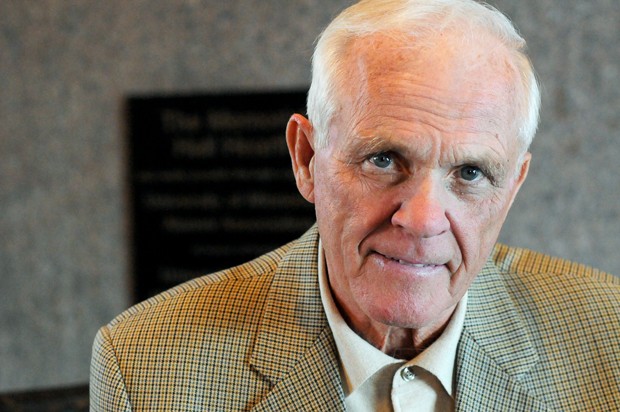EditorâÄôs Note: This is the first in a two-part series looking at UMore Park. The second part will examine the UniversityâÄôs academic mission in relation to its use of the property. Larry Laukka only took one course on how to create a community during his time at the University of Minnesota, but the class shaped the rest of his life. In the 48 years heâÄôs spent designing, financing, constructing and managing real estate, Laukka has created 45 developments around the Twin Cities. Now, heâÄôs the director of commercial development in the University of Minnesota Outreach, Research and Education Park endeavor. UMore Park could be home to up to 30,000 people once itâÄôs developed. Laukka graduated from the University in 1958 with a degree in economics, but he spent his career developing property around the Twin Cities. As a student, he was involved in a fraternity, which he said showed him the importance of giving back to the institution. He returned to the University as a volunteer in the 1980s. Fred Friswold, who was president of the University of Minnesota Alumni Association at the time, called on Laukka to help get McNamara Alumni Center constructed, a process that took nearly 10 years. Margaret Sughrue Carlson, the retiring CEO of the Alumni Association, said it was Laukka who pushed for a bigger, more distinctive alumni center. âÄúLarry urged us to think big, bring in partners, consider innovative funding and fundraising options and invite signature architects to bid on the project,âÄù Carlson said in an e-mail. âÄúNothing was easy and nothing was linear in this project that spanned a decade.âÄù Laukka is also responsible for ScholarâÄôs Walk, the alumni plaza and the Alumni Wall of Honor. HeâÄôll sometimes drive around the communities heâÄôs built, which lie primarily southwest of Minneapolis, just to âÄúsee them survive,âÄù Laukka said. He has invested his career in every aspect of real estate development and finds the most enjoyment in turning a faceless piece of land into a unique, utilized community. âÄúBuilding it is kind of fun, managing is kind of fun, but the real fun is taking that blank piece of paper,âÄù Laukka said. UMore Park, the UniversityâÄôs 5,000-acre plot of land located 25 miles southeast of the Twin Cities, is just the blank page Laukka can use. He pushed for the landâÄôs development as far back as 1996 when he was first offered a look at the property. Friswold, a longtime friend and one of LaukkaâÄôs fraternity brothers, said Laukka spent several years convincing the University of the âÄúvaluable assetâÄù it has in UMore Park. âÄú[He] stirred the pot a lot until finally others got interested and could see the potential,âÄù Friswold said, pointing to LaukkaâÄôs Scandinavian roots that make him âÄústubborn and persistentâÄù in his quest to get something done. It took nearly 10 years and a new president for the University to take a more serious look at what to do with UMore Park. In 2005, University President Bob Bruininks formed a task force, on which Laukka served, to determine the viable options. The committee returned to the Board of Regents with three choices: leave the land as is, sell it in pieces or develop it. In 2009, the board approved the establishment of a limited liability company, led by a board of governors, to oversee the UniversityâÄôs stake in the property. By the end of 2011, the LLC will be operating entirely on its own, having paid back its $4.8 million debt to the University. Because the University controls all 5,000 acres that make up UMore Park, Laukka said he sees it as the UniversityâÄôs opportunity to pave a new way in sustainability and community building. It will take 25 to 30 years to complete, but the University has the ability to keep the land and wait that long. As one who spent his career building communities as part of the private sector, Laukka said he knows this is a rare opportunity. He envisions a lasting and sustainable community, home to âÄúregular folks.âÄù He said it could be a milestone. âÄúI donâÄôt expect weâÄôre going to turn the world upside down and build Nirvana. But I do think we can do that better,âÄù Laukka said of the prospective community. Right now the University still has to secure the licenses necessary to begin development. The process will be long and tedious because of the UniversityâÄôs status as a public institution. But the results will be the same as they would if a private developer had control of the property, Laukka said. The University developed a master plan for the land, presented in October 2008, which details the dream of UMore Park. Approximately 2,800 acres will be called Vermillion Highlands and will be used for research, recreation and wildlife management. The remainder of the land will become a compact community with neighborhoods within walking distance of commercial property and walking trails. Bus lines will be included to discourage unnecessary use of vehicles. Though it may have looked the same if developed in the private sector, the University has the opportunity to use the land for research, Laukka said, a responsibility it has as the stateâÄôs only land-grant institution. Some University projects will have to wait until the development is further along, but others will be a part of the process. The time it takes to develop the land will provide the opportunity to enact new practices and do something completely different. -Taryn Wobbema is a senior staff reporter.











